child lock Peugeot 508 RXH 2014 Owner's Manual
[x] Cancel search | Manufacturer: PEUGEOT, Model Year: 2014, Model line: 508 RXH, Model: Peugeot 508 RXH 2014Pages: 338, PDF Size: 10.81 MB
Page 5 of 338
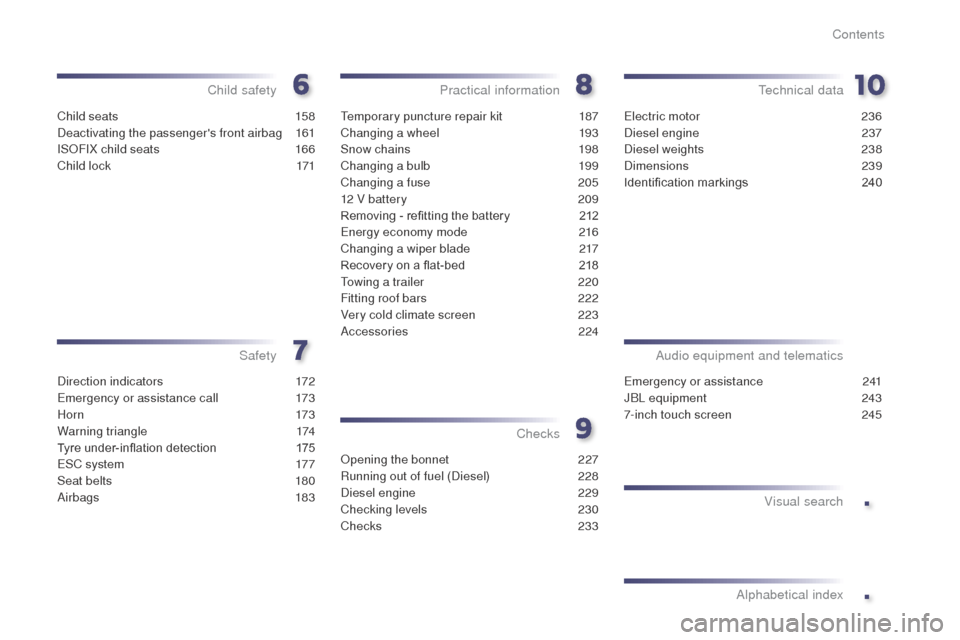
.
.
508RXH_en_Chap00a_sommaire_ed01-2014
Child seats 158
Deactivating the passenger's front airbag
1
61
ISOFIX child seats
1
66
Child lock
1
71
Child safety
Direction indicators 172
em
ergency or assistance call
1
73
H o r n
173
Warning triangle
1
74
Tyre under-inflation detection
1
75
e
SC system
1
77
Seat belts
1
80
Airbags
1
83
Safety
temporary puncture repair kit 1 87
Changing a wheel
1
93
Snow chains
1
98
Changing a bulb
1
99
Changing a fuse
2
05
12 V battery
2
09
Removing - refitting the battery
2
12
en
ergy economy mode
2
16
Changing a wiper blade
2
17
Recovery on a flat-bed
2
18
to
wing a trailer
2
20
Fitting roof bars
2
22
Very cold climate screen
2
23
Accessories
224
Practical information
Opening the bonnet 2 27
Running out of fuel (Diesel)
2
28
Diesel engine
2
29
Checking levels
23
0
Checks
233
Checks
electric motor 2 36
Diesel engine
2
37
Diesel weights
23
8
Dimensions
239
Identification markings
2
40
technical data
emergency or assistance 2 41
JBL equipment
2
43
7-inch touch screen
2
45
Audio equipment and telematics
Alphabetical indexVisual search
Contents
Page 11 of 338
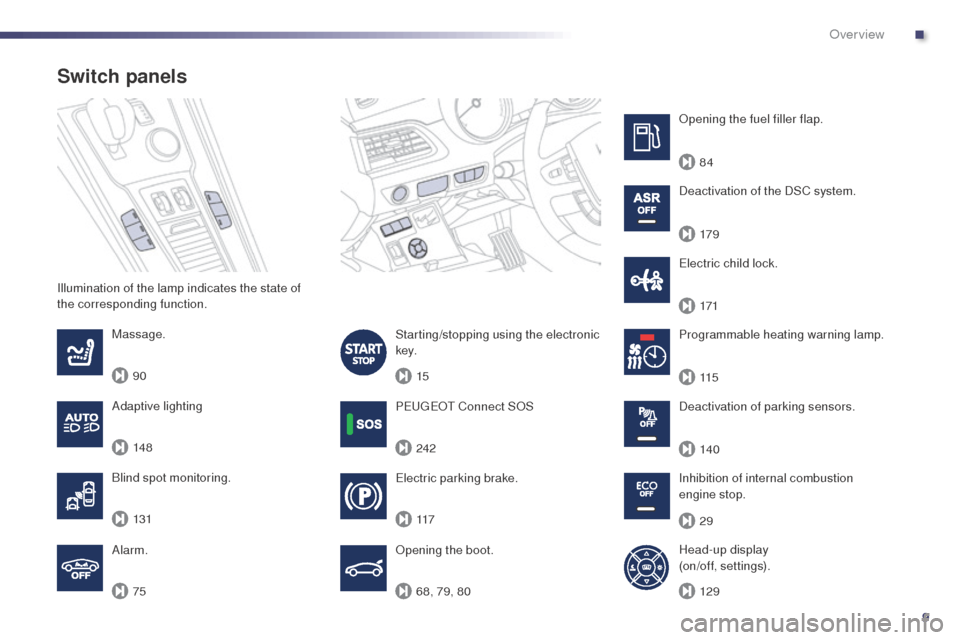
9
90
75 131 148117
68, 79, 80 242 15 171
115
140
29
129 179 84
508RXH_en_Chap00b_vue-ensemble_ed01-2014
Illumination of the lamp indicates the state of
the corresponding function.
Switch panels
electric parking brake.
Opening the boot.
Massage.
Alarm.
el
ectric child lock.
Programmable heating warning lamp.
Deactivation of parking sensors.
Inhibition of internal combustion
engine stop.
Head-up display
(on/off, settings).
Peuge
O
t
Connect SOS
Starting/stopping using the electronic
key.
Blind spot monitoring. Deactivation of the DSC system. Opening the fuel filler flap.
Adaptive lighting
.
Over view
Page 71 of 338
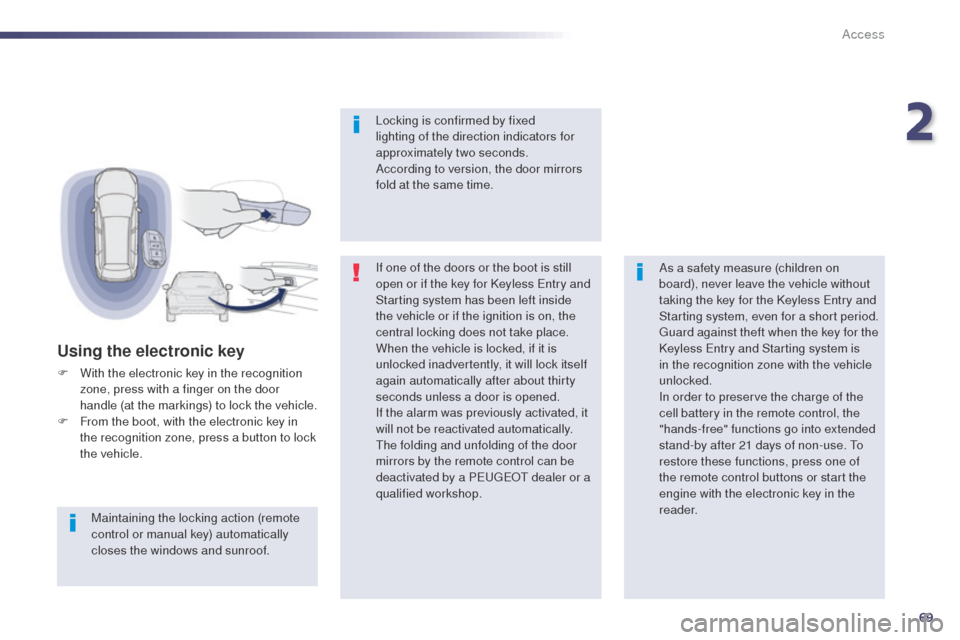
69
508RXH_en_Chap02_ouvertures_ed01-2014
If one of the doors or the boot is still
open or if the key for Keyless en try and
Starting system has been left inside
the vehicle or if the ignition is on, the
central locking does not take place.
When the vehicle is locked, if it is
unlocked inadvertently, it will lock itself
again automatically after about thirty
seconds unless a door is opened.
If the alarm was previously activated, it
will not be reactivated automatically.
th
e folding and unfolding of the door
mirrors by the remote control can be
deactivated by a P
e
uge
Ot
dealer or a
qualified workshop. Locking is confirmed by fixed
lighting of the direction indicators for
approximately two seconds.
According to version, the door mirrors
fold at the same time.
As a safety measure (children on
board), never leave the vehicle without
taking the key for the Keyless e
n
try and
Starting system, even for a short period.
gu
ard against theft when the key for the
Keyless
e
n
try and Starting system is
in the recognition zone with the vehicle
unlocked.
In order to preserve the charge of the
cell battery in the remote control, the
"hands-free" functions go into extended
stand-by after 21 days of non-use.
t
o
r
estore these functions, press one of
the remote control buttons or start the
engine with the electronic key in the
reader.
Using the electronic key
F With the electronic key in the recognition zone, press with a finger on the door
handle (at the markings) to lock the vehicle.
F
F
rom the boot, with the electronic key in
the recognition zone, press a button to lock
the vehicle.
Maintaining the locking action (remote
control or manual key) automatically
closes the windows and sunroof.
2
Access
Page 74 of 338
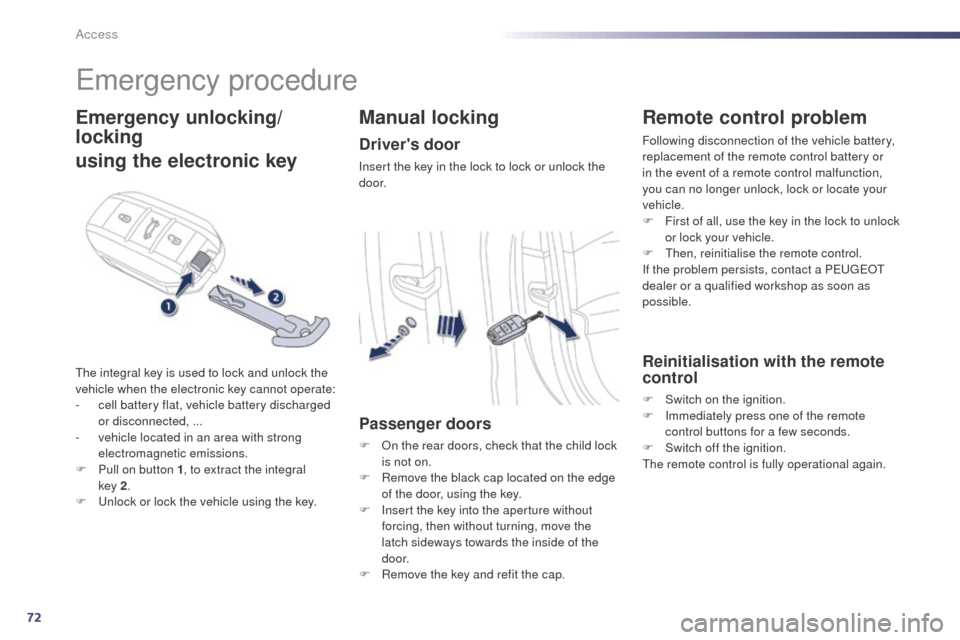
72
508RXH_en_Chap02_ouvertures_ed01-2014
emergency procedure
Emergency unlocking/
locking
using the electronic key
the integral key is used to lock and unlock the
vehicle when the electronic key cannot operate:
-
c
ell battery flat, vehicle battery discharged
or disconnected, ...
-
v
ehicle located in an area with strong
electromagnetic emissions.
F
P
ull on button 1 , to extract the integral
key
2.
F
u
n
lock or lock the vehicle using the key.
Manual locking
Driver's door
Insert the key in the lock to lock or unlock the
d o o r.
Passenger doors
F On the rear doors, check that the child lock is not on.
F
R
emove the black cap located on the edge
of the door, using the key.
F
I
nsert the key into the aperture without
forcing, then without turning, move the
latch sideways towards the inside of the
d o o r.
F
R
emove the key and refit the cap.
Remote control problem
Following disconnection of the vehicle battery,
replacement of the remote control battery or
in the event of a remote control malfunction,
you can no longer unlock, lock or locate your
vehicle.
F
F
irst of all, use the key in the lock to unlock
or lock your vehicle.
F
t
hen
, reinitialise the remote control.
If the problem persists, contact a P
e
uge
Ot
dealer or a qualified workshop as soon as
possible.
Reinitialisation with the remote
control
F Switch on the ignition.
F I mmediately press one of the remote
control buttons for a few seconds.
F
S
witch off the ignition.
th
e remote control is fully operational again.
Access
Page 76 of 338
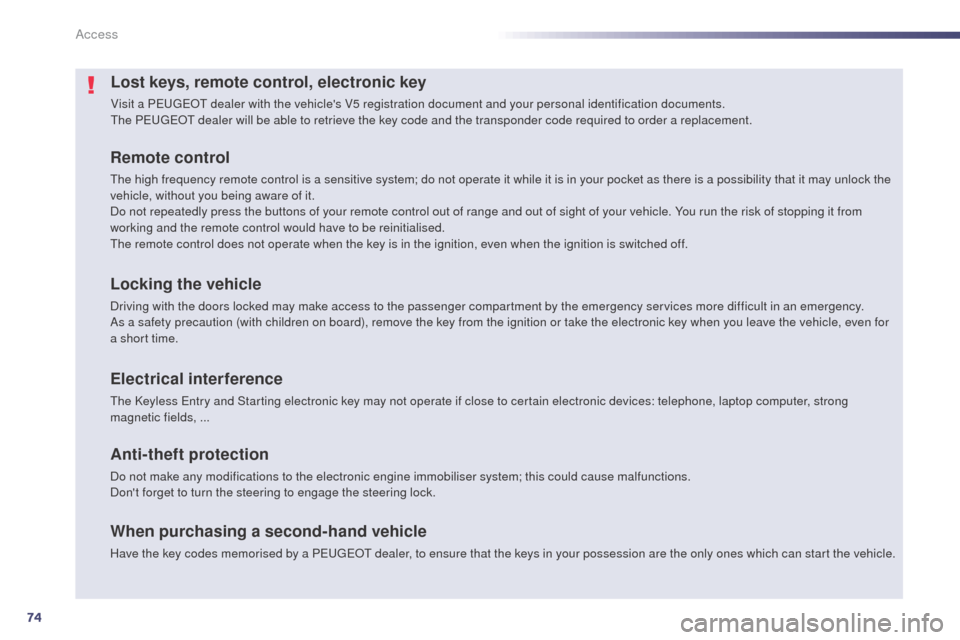
74
508RXH_en_Chap02_ouvertures_ed01-2014
Lost keys, remote control, electronic key
Visit a PeugeOt dealer with the vehicle's V5 registration document and your personal identification documents.th
e Pe ugeOt dealer will be able to retrieve the key code and the transponder code required to order a replacement.
Remote control
the high frequency remote control is a sensitive system; do not operate it while it is in your pocket as there is a possibility that it may unlock the
vehicle, without you being aware of it.
Do not repeatedly press the buttons of your remote control out of range and out of sight of your vehicle. You run the risk of stopping it from
working and the remote control would have to be reinitialised.
th
e remote control does not operate when the key is in the ignition, even when the ignition is switched off.
Locking the vehicle
Driving with the doors locked may make access to the passenger compartment by the emergency services more difficult in an emergency.
As a safety precaution (with children on board), remove the key from the ignition or take the electronic key when you leave the vehicle, even for
a short time.
Electrical interference
the Keyless en try and Starting electronic key may not operate if close to certain electronic devices: telephone, laptop computer, strong
magnetic fields, ...
Anti-theft protection
Do not make any modifications to the electronic engine immobiliser system; this could cause malfunctions.
Don't forget to turn the steering to engage the steering lock.
When purchasing a second-hand vehicle
Have the key codes memorised by a Pe ugeOt dealer, to ensure that the keys in your possession are the only ones which can start the vehicle.
Access
Page 79 of 338
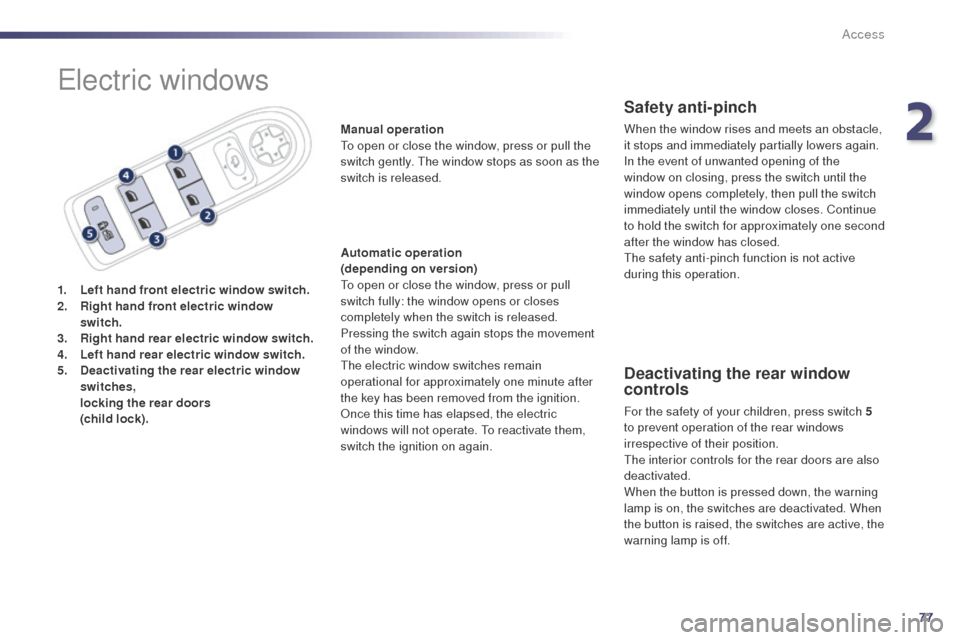
77
508RXH_en_Chap02_ouvertures_ed01-2014
electric windows
1. Left hand front electric window switch.
2. Right hand front electric window
switch.
3.
R
ight hand rear electric window switch.
4.
Le
ft hand rear electric window switch.
5.
D
eactivating the rear electric window
switches,
lo
cking the rear doors
(
child lock). Manual operation
to o
pen or close the window, press or pull the
switch gently. t
h
e window stops as soon as the
switch is released.
Automatic operation
(depending on version)to o pen or close the window, press or pull
switch fully: the window opens or closes
completely when the switch is released.
Pressing the switch again stops the movement
of the window.
the
electric window switches remain
operational for approximately one minute after
the key has been removed from the ignition.
Once this time has elapsed, the electric
windows will not operate.
t
o r
eactivate them,
switch the ignition on again.
Safety anti-pinch
When the window rises and meets an obstacle,
it stops and immediately partially lowers again.
In the event of unwanted opening of the
window on closing, press the switch until the
window opens completely, then pull the switch
immediately until the window closes. Continue
to hold the switch for approximately one second
after the window has closed.
th
e safety anti-pinch function is not active
during this operation.
Deactivating the rear window
controls
For the safety of your children, press switch 5
t o prevent operation of the rear windows
irrespective of their position.
th
e interior controls for the rear doors are also
deactivated.
When the button is pressed down, the warning
lamp is on, the switches are deactivated. When
the button is raised, the switches are active, the
warning lamp is off.
2
Access
Page 172 of 338
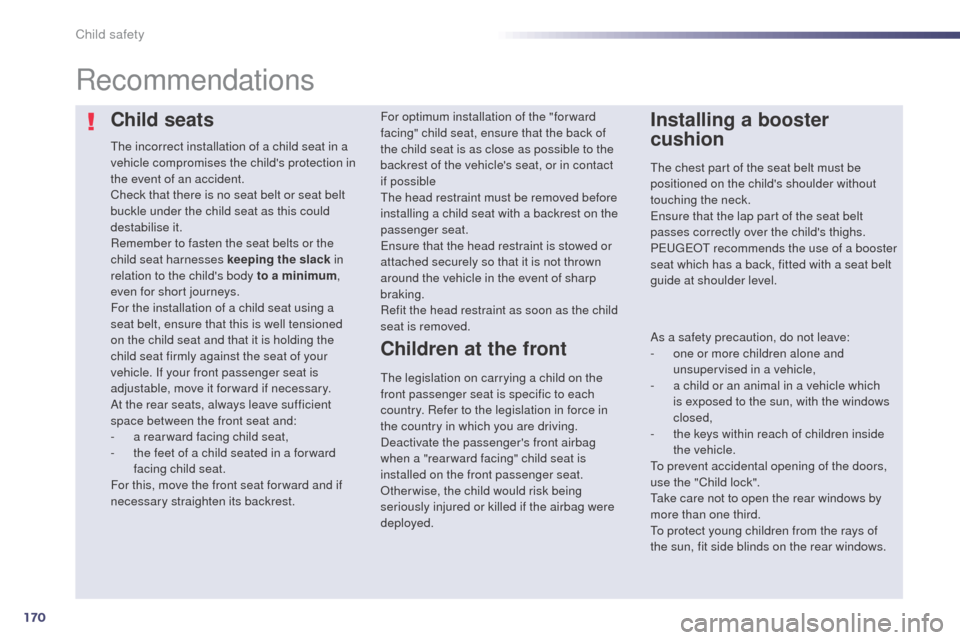
170
508RXH_en_Chap06_securite-enfants_ed01-2014
Child seats
the incorrect installation of a child seat in a
vehicle compromises the child's protection in
the event of an accident.
Check that there is no seat belt or seat belt
buckle under the child seat as this could
destabilise it.
Remember to fasten the seat belts or the
child seat harnesses keeping the slack in
relation to the child's body to a minimum,
even for short journeys.
For the installation of a child seat using a
seat belt, ensure that this is well tensioned
on the child seat and that it is holding the
child seat firmly against the seat of your
vehicle. If your front passenger seat is
adjustable, move it forward if necessary.
At the rear seats, always leave sufficient
space between the front seat and:
-
a r
ear ward facing child seat,
-
t
he feet of a child seated in a for ward
facing child seat.
For this, move the front seat for ward and if
necessary straighten its backrest.
Recommendations
As a safety precaution, do not leave:
- o ne or more children alone and
unsupervised in a vehicle,
-
a c
hild or an animal in a vehicle which
is exposed to the sun, with the windows
closed,
-
t
he keys within reach of children inside
the vehicle.
to p
revent accidental opening of the doors,
use the "Child lock".
ta
ke care not to open the rear windows by
more than one third.
to p
rotect young children from the rays of
the sun, fit side blinds on the rear windows.
th
e chest part of the seat belt must be
positioned on the child's shoulder without
touching the neck.
en
sure that the lap part of the seat belt
passes correctly over the child's thighs.
P
e
uge
Ot
recommends the use of a booster
seat which has a back, fitted with a seat belt
guide at shoulder level.
For optimum installation of the "forward
facing" child seat, ensure that the back of
the child seat is as close as possible to the
backrest of the vehicle's seat, or in contact
if possible
th
e head restraint must be removed before
installing a child seat with a backrest on the
passenger seat.
en
sure that the head restraint is stowed or
attached securely so that it is not thrown
around the vehicle in the event of sharp
braking.
Refit the head restraint as soon as the child
seat is removed.Children at the front
the legislation on carrying a child on the
front passenger seat is specific to each
country. Refer to the legislation in force in
the country in which you are driving.
Deactivate the passenger's front airbag
when a "rear ward facing" child seat is
installed on the front passenger seat.
Otherwise, the child would risk being
seriously injured or killed if the airbag were
deployed.
Installing a booster
cushion
Child safety
Page 173 of 338
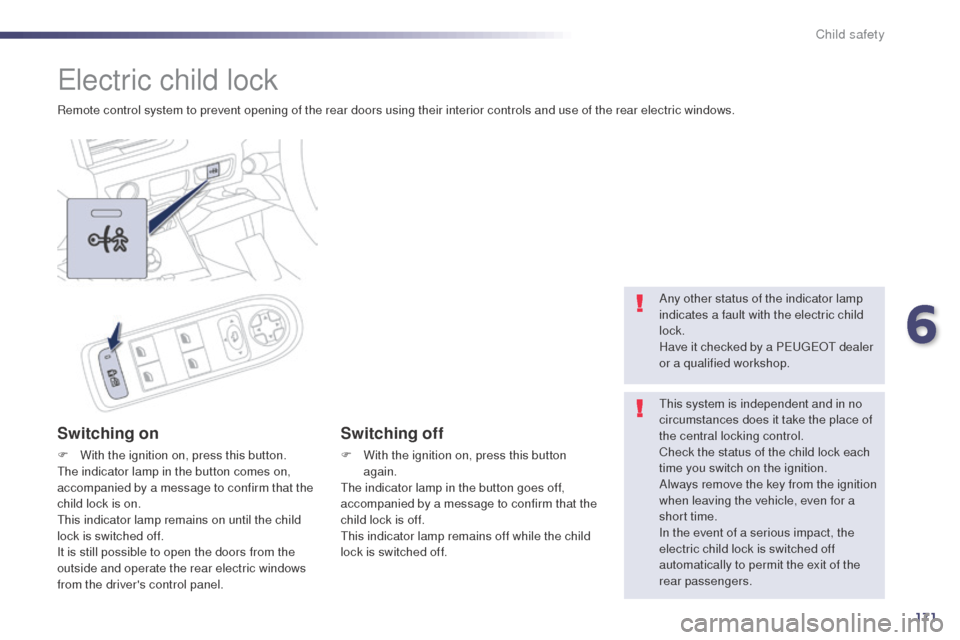
171
508RXH_en_Chap06_securite-enfants_ed01-2014
electric child lock
Remote control system to prevent opening of the rear doors using their interior controls and use of the rear electric windows.
Switching on
F With the ignition on, press this button.the indicator lamp in the button comes on,
accompanied by a message to confirm that the
child lock is on.
th
is indicator lamp remains on until the child
lock is switched off.
It is still possible to open the doors from the
outside and operate the rear electric windows
from the driver's control panel.
Switching off
F With the ignition on, press this button again.
th
e indicator lamp in the button goes off,
accompanied by a message to confirm that the
child lock is off.
th
is indicator lamp remains off while the child
lock is switched off. Any other status of the indicator lamp
indicates a fault with the electric child
lock.
Have it checked by a P
e
uge
Ot
dealer
or a qualified workshop.
th
is system is independent and in no
circumstances does it take the place of
the central locking control.
Check the status of the child lock each
time you switch on the ignition.
Always remove the key from the ignition
when leaving the vehicle, even for a
short time.
In the event of a serious impact, the
electric child lock is switched off
automatically to permit the exit of the
rear passengers.
6
Child safety
Page 184 of 338
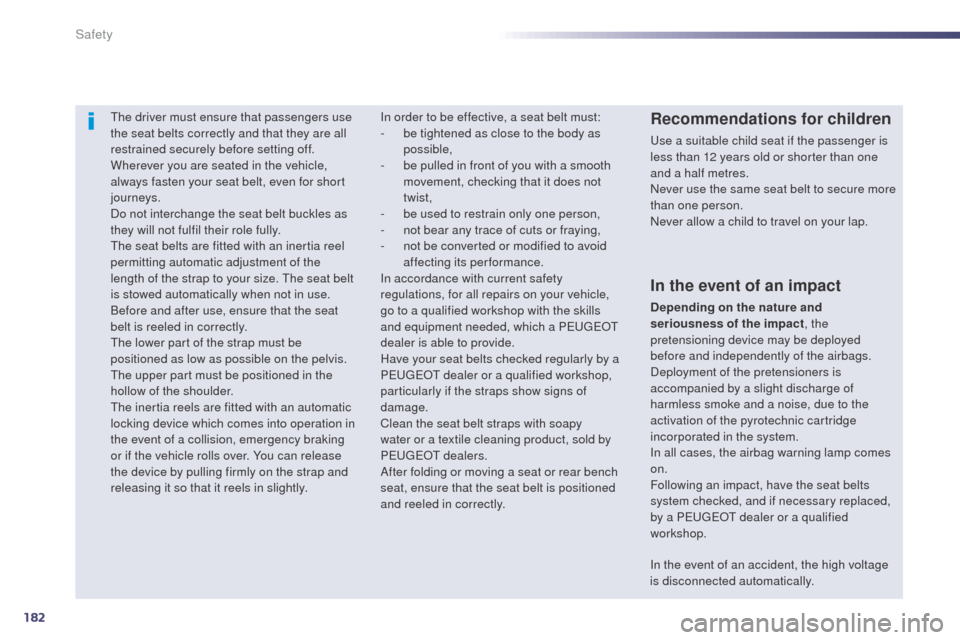
182
508RXH_en_Chap07_securite_ed01-2014
the driver must ensure that passengers use
the seat belts correctly and that they are all
restrained securely before setting off.
Wherever you are seated in the vehicle,
always fasten your seat belt, even for short
journeys.
Do not interchange the seat belt buckles as
they will not fulfil their role fully.
th
e seat belts are fitted with an inertia reel
permitting automatic adjustment of the
length of the strap to your size.
t
h
e seat belt
is stowed automatically when not in use.
Before and after use, ensure that the seat
belt is reeled in correctly.
th
e lower part of the strap must be
positioned as low as possible on the pelvis.
th
e upper part must be positioned in the
hollow of the shoulder.
th
e inertia reels are fitted with an automatic
locking device which comes into operation in
the event of a collision, emergency braking
or if the vehicle rolls over. You can release
the device by pulling firmly on the strap and
releasing it so that it reels in slightly.Recommendations for children
use a suitable child seat if the passenger is
less than 12 years old or shorter than one
and a half metres.
Never use the same seat belt to secure more
than one person.
Never allow a child to travel on your lap.
In order to be effective, a seat belt must:
-
b
e tightened as close to the body as
possible,
-
b
e pulled in front of you with a smooth
movement, checking that it does not
twist,
-
b
e used to restrain only one person,
-
n
ot bear any trace of cuts or fraying,
-
n
ot be converted or modified to avoid
affecting its performance.
In accordance with current safety
regulations, for all repairs on your vehicle,
go to a qualified workshop with the skills
and equipment needed, which a P
e
uge
Ot
dealer is able to provide.
Have your seat belts checked regularly by a
P
e
uge
Ot
dealer or a qualified workshop,
particularly if the straps show signs of
damage.
Clean the seat belt straps with soapy
water or a textile cleaning product, sold by
P
e
uge
Ot d
ealers.
After folding or moving a seat or rear bench
seat, ensure that the seat belt is positioned
and reeled in correctly.
In the event of an impact
Depending on the nature and
seriousness of the impact , the
pretensioning device may be deployed
before and independently of the airbags.
Deployment of the pretensioners is
accompanied by a slight discharge of
harmless smoke and a noise, due to the
activation of the pyrotechnic cartridge
incorporated in the system.
In all cases, the airbag warning lamp comes
on.
Following an impact, have the seat belts
system checked, and if necessary replaced,
by a P
e
uge
Ot
dealer or a qualified
workshop.
In the event of an accident, the high voltage
is disconnected automatically.
Safety
Page 318 of 338
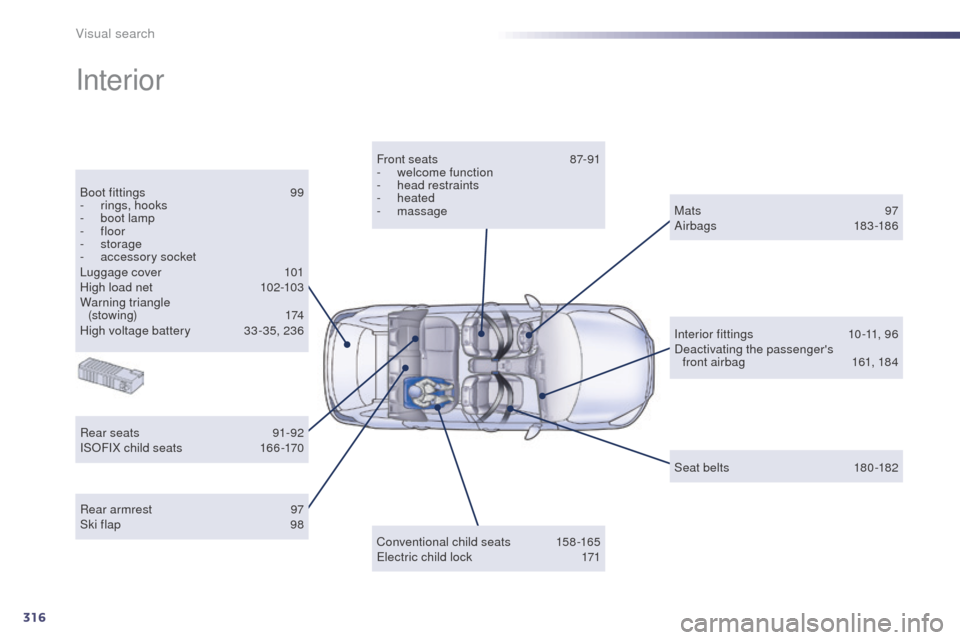
316
508RXH_en_Chap12_recherche-visuelle_ed01-2014
Interior
Boot fittings 99
- r ings, hooks
-
b
oot lamp
-
floor
-
storage
-
a
ccessory socket
Luggage cover
1
01
High load net
1
02-103
Warning triangle (stowing)
1
74
High voltage battery
3
3 -35, 236
Conventional child seats
1
58 -165
el
ectric child lock
1
71
Front seats
87
-91
-
w
elcome function
- h ead restraints
- heated
-
massage
Rear armrest
9
7
Ski flap
9
8 Mats
97
A
irbags
18
3 -18 6
Interior fittings
1
0 -11, 96
Deactivating the passenger's front airbag
1
61, 184
Seat belts
1
80-182
Rear seats
9
1-92
ISOFIX child seats
1
66 -170
Visual search